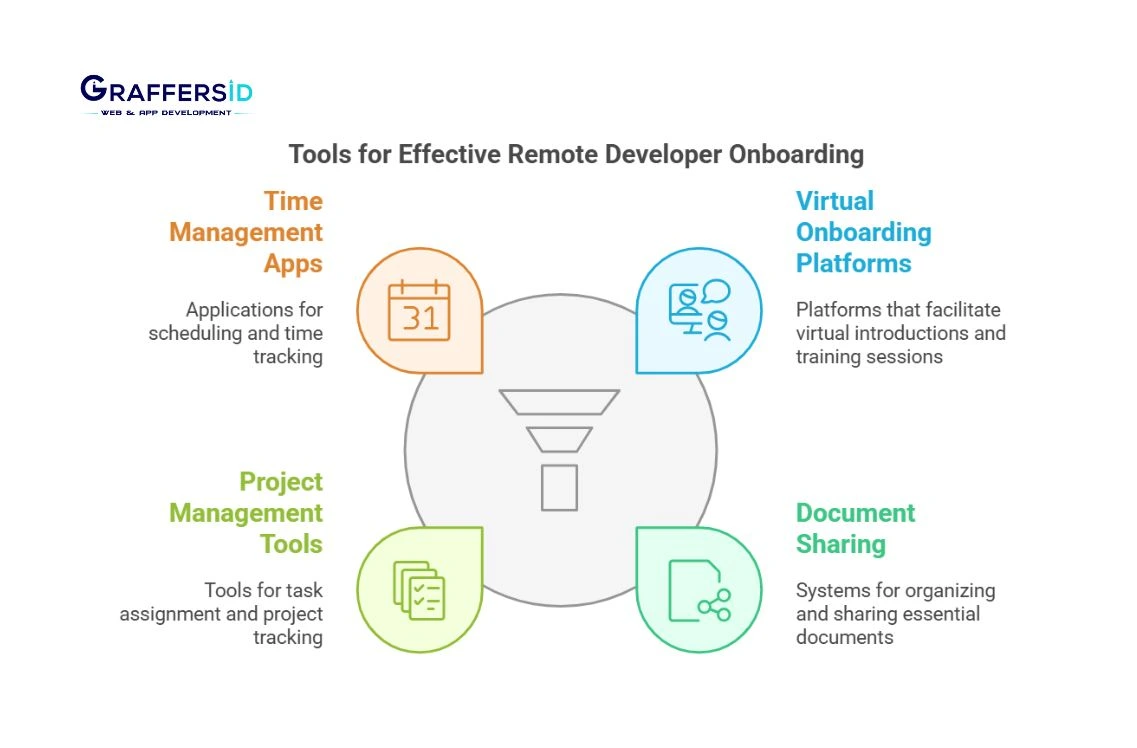As remote work becomes more popular, firms are increasingly hiring remote developers to tap into global talent. However, the onboarding process, an essential component of managing remote teams, is sometimes overlooked. A bad onboarding experience can lead to disengagement and increased turnover, whereas a well-structured remote developer onboarding process can lay the groundwork for long-term success.
To address the opportunities enabled by remote work and the challenges that flow from it, the remote developer onboarding practices must be changed as of 2025. This change ensures that the remote developers feel wanted, protected, and on track with the organizational objectives right from the beginning.
Key Elements of a Successful Remote Developer Onboarding Process

A successful onboarding process does more than just simply introduce the new employees to the company’s guidelines and procedures. Instead, it is a complete process that guarantees the new employees have everything they need to properly adapt to the new workflow and environment.
The following are some essential components of an effective remote developer onboarding process:
1. Pre-boarding Preparation
- Before the developer’s first day, ensure they receive all necessary hardware and software, such as laptops, software licenses, and access to key systems.
- Provide detailed documentation and a timetable for the initial weeks.
- Create accounts and permissions for internal technologies, including email, Slack, project management systems, and collaboration platforms.
2. Welcome Package
- Send them a personalized welcome email along with a corporate gift box (t-shirts, mugs, etc.) to make them feel appreciated.
- Create a virtual induction event so they can introduce themselves to their new colleagues.
3. Orientation to Company Culture
- Highlight the principles, mission, and vision of the company at the beginning.
- Additionally, providing daily team-building exercises will help new remote developers interact with the team.
- Allow them to get acquainted with employees from different departments to provide them with general information about the firm.
4. Training on Tools and Technologies
- Educate the staff thoroughly about the tools and technologies used by the company.
- Every new joiner should be paired with a mentor or lead developer who will guide them in familiarizing themselves with codes, project flows, and other operations.
5. Ongoing Feedback and Adjustments
- Set up regular check-ins, especially during the first few weeks, to address any problems and ensure the developer feels supported.
- Collect feedback from the new hire on the onboarding process and then make improvements accordingly.
Read More: How to Find and Hire Dedicated Remote Development Team?
Tools to Streamline Remote Developer Onboarding Process

The remote developer onboarding process can be challenging without the right tools. When used properly, tools and technologies may simplify all the processes, making them more precise and advantageous to both the company and the remote developers.
1. Virtual Employee Onboarding Platforms
- The HR team can customize the remote onboarding processes using platforms such as WorkBright, BambooHR, and Rippling. Apart from this, they allow paperwork management automation and compliance checks, which ensures that remote developers do not miss any critical joining formalities.
2. Document Sharing and Knowledge Management
- Cloud-based platforms like Google Drive, Notion, or Confluence can be used for data sharing or to store all important files or documents in one place.
- Get an online portal created for the newly hired employees, which can help them access all the necessary information about the company as well as the training material.
3. Project Management and Collaboration Tools
- Tools like Trello, Asana, and Jira can help handle tasks, track progress, and manage the progress of remote developers towards the project.
- Slack is a helpful application for work interaction; it allows you to share files and have virtual meetings with colleagues in real-time.
- The onboarding processes can be conducted online using tools such as Zoom and Google Meet, and review sessions can also be scheduled through video conferences.
4. Time Management applications
- Remote developers can use applications like Toggl or Clockify to track their working hours and provide managers with the status of the projects.
Mentorship and Support for New Remote Developers

It is critical to ensure that new remote developers can work effectively to ensure long-term success. This is why providing proper support and mentoring to new employees is important. Limited direct interaction may also cause remote developers to suffer from isolation or exclusion.
Here’s how to set up a mentorship program for newly hired remote developers:
1. Assign a Dedicated Mentor
- Assign a reporting senior or manager to the new developer to answer their doubts and receive work reports.
- Setting up frequent discussions will guarantee that the remote developer will have an advisor or a mentor.
2. Encourage Pair Programming
- Pair programming is a way in which a new remote developer works with senior team members to learn and gain knowledge.
- Other strategies, like using screen sharing through Visual Studio Live Share or Tuple, facilitate coding practice and learning.
3. Provide Emotional and Mental Health Support
- While working remotely, employees may experience problems of burnout or loneliness. Educate new employees on how to manage mental health and work-life balance effectively.
- Set up weekly or bi-weekly meetings with HR or managing authorities to know about the new developers’ thoughts or experiences in their roles.
4. Continuous Learning and Development Opportunities
- Ensure that the new remote developers are open to discussions and activities by providing them with courses, tutorials, and industry meetings.
- Offer opportunities for professional development, whether through internal promotions or new projects, to keep them motivated and engaged.
Setting Clear Expectations and Goals for Remote Teams

Businesses should set clear goals to efficiently manage remote teams and keep employees productive and focused on organizational objectives. It is important to ensure that the remote developers understand your expectations of their work and how it contributes to the overall goals of the team and the company while they are being onboarded.
1. Set Specific, Measurable Goals
- Set achievable short-term and long-term goals for the developers, including the projects’ timeline, code quality, and overall performance.
- The goals should be SMART (specific, measurable, achievable, relevant, and time-bound) so that both developers and managers can assess progress.
2. Clarify Communication Expectations
- Provide all the specifications required to be followed, including preferred mediums used for interactions, response time and availability, etc.
- Make sure that the remote developer knows what level of interaction with the rest of the teams is expected and how often they have to report to their manager.
3. Document Processes and Procedures
- Remote developers should be told not only about what to do but also how to do it. It is crucial to specify all the existing workflows, coding standards, and development processes.
- Provide clear instructions for work submissions, pull request collaborations, and the code of conduct.
4. Foster a Results-Oriented Environment
- Instead of supervising the task throughout the day, focus on the actual end product. Encourage ownership over a part of the work done by the developer and let them know that they are on their own but backed up.
Read More: How to Hire Remote Developers from India: A Comprehensive Guide
Conclusion
A properly planned remote developer onboarding process may greatly affect the success of remote developers. To enhance the success of remote teams, set up key factors by optimal planning, providing training, and setting clear goals. As discussed in the blog, with the right tools and processes, the remote developers’ onboarding process can be made smooth, efficient, and engaging.
GraffersID understands the challenges of onboarding remote developers. As a professional team with previous experience working with remote teams, we can ensure an effective onboarding to ensure your remote developers achieve success.
Call us today to find out how we could assist you in hiring and managing the best remote talent and how you can create a remote team successfully.




